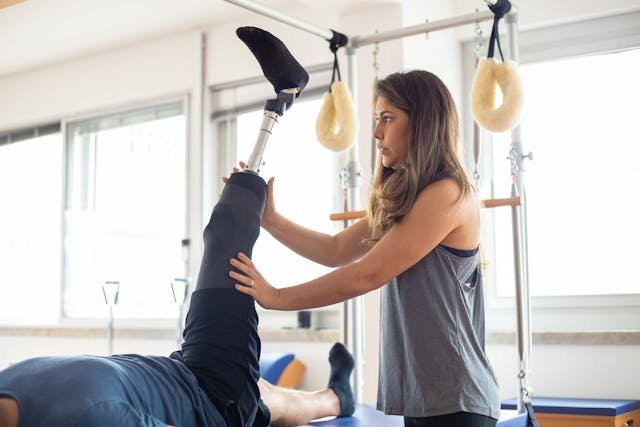Learning to walk again after an amputation is a journey that takes patience, effort, and the right support. Whether you use a transtibial (below-knee) or transfemoral (above-knee) prosthetic, improving mobility is not just about using a device—it’s about training your body to move in new ways and building confidence with every step. Mobility is something that grows over time, with the right techniques and habits guiding the way.
At Robobionics, we work closely with prosthetic users across India, helping them move from the first fitting to a life of independence. This article explores how to train and improve mobility using either a transtibial or transfemoral prosthetic. From balance exercises and walking practice to strength building and daily routines, you’ll learn how to take steady, meaningful steps toward better movement and more freedom.
Starting the Journey: First Steps with Your Prosthetic
The beginning of your mobility journey starts not with walking, but with learning how your prosthetic fits into your daily life. Before you take your first steps, it’s important to understand your device and your body’s new movement pattern.
Getting Comfortable with the Fit and Feel
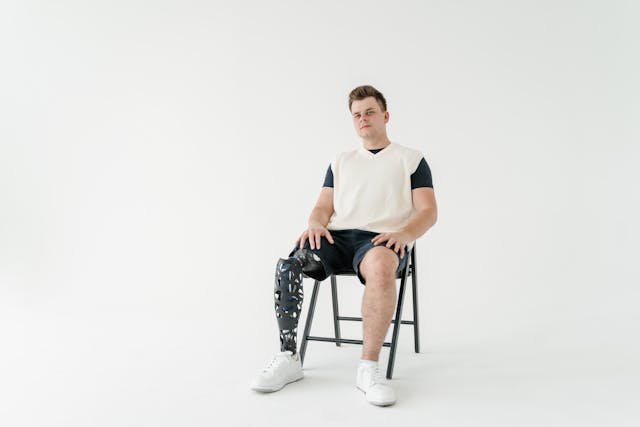
When you first receive your prosthetic, the socket—the part that connects to your limb—may feel strange. It takes time for your skin and muscles to adjust. It’s normal to feel a bit of pressure or awkwardness, especially if this is your first experience. The key is to wear the prosthetic for short periods at first, gradually increasing the time each day.
For transtibial users, the presence of the knee joint makes movement more familiar. For transfemoral users, where the knee is replaced by a mechanical or smart joint, it may take more time to trust the device. Learning to move the limb forward and place the foot correctly begins with small, mindful movements.
Our team at Robobionics works with users through demo and trial sessions, helping them understand the fit and showing them simple exercises to ease the body into wearing and using the prosthesis with confidence.
Practicing Weight Shifting and Balance
Before walking begins, you must learn to balance while standing still. With a prosthetic, your weight may not be evenly distributed at first. Practicing how to shift your weight from one leg to the other helps your brain and muscles understand how the prosthesis responds.
Simple standing exercises—like placing equal weight on both legs or shifting gently from side to side—are the foundation of mobility. These movements help you feel more stable and reduce the fear of falling. They also strengthen the muscles around your hip, knee, and core.
These early movements are not difficult, but they are very important. They teach your body how to trust the prosthetic and move with it, rather than resisting it. Practicing daily, even for five to ten minutes, sets the stage for smoother walking later.
Building Trust Through Repetition
Trust is one of the biggest parts of mobility training. Trust in your body. Trust in your prosthetic. Trust in the process. That trust only grows with repetition. The more you practice basic movements, the more natural they feel.
At first, you may need support from parallel bars, a walker, or a family member. Over time, you’ll notice your body adapting—standing longer, stepping further, or holding better posture. Each small success builds the next.
Robobionics encourages users to take it slow but stay consistent. Our gamified rehab tools make repetition more engaging, turning simple steps into fun and measurable progress. You don’t have to rush—but you do have to keep moving forward, one step at a time.
Learning to Walk Again with a Transtibial Prosthetic

Transtibial users have a big advantage—their natural knee joint is still present. This helps with stability and control. But learning to walk still requires new muscle memory, coordination, and a strong sense of balance.
Using the Whole Foot for Smoother Steps
One of the most important things to learn is how to use the prosthetic foot properly. Some users tend to put weight only on the heel or toe, which can make walking uneven or cause discomfort. Practicing full-foot contact during each step helps improve balance and walking speed.
During walking, the heel should touch the ground first, followed by a smooth roll through the middle of the foot, and finally a gentle push off the toe. Practicing this motion with the prosthetic foot helps create a rhythm that matches your natural leg.
At Robobionics, we work with users to understand this step pattern, often starting with slow, guided walks that allow the brain and muscles to adjust without rushing. With time, users develop a steady, natural gait that feels more like walking than managing a device.
Training the Muscles That Support the Leg
Even with the knee in place, the muscles around your residual limb, hip, and lower back need to be retrained. These muscles have a new job now—they must stabilize the socket and guide the leg during motion.
Strength training for transtibial users often includes exercises like gentle squats, step-ups, or seated leg lifts. These exercises are not only safe but highly effective when done regularly. They build endurance and allow for longer walking sessions without fatigue.
The stronger your muscles become, the less pressure is placed on the socket, and the smoother your walking becomes. Robobionics offers guided rehab plans that help users work these muscles gradually, making strength-building feel like a natural part of the day.
Practicing Turns, Ramps, and Real-World Movement
Walking in a straight line is one thing—turning corners, walking up ramps, or stepping onto uneven ground is another. These real-life movements are what make you feel truly mobile, and they take practice.
Start by practicing controlled turns, placing weight carefully while rotating. Then try walking on small slopes or uneven surfaces with a support person nearby. Each new surface teaches your body how to respond and adapt without losing balance.
Our goal at Robobionics is to help users not just walk, but move confidently in real life. That means being ready for whatever path lies ahead, and learning how to move through it with control and ease.
Improving Mobility with a Transfemoral Prosthetic
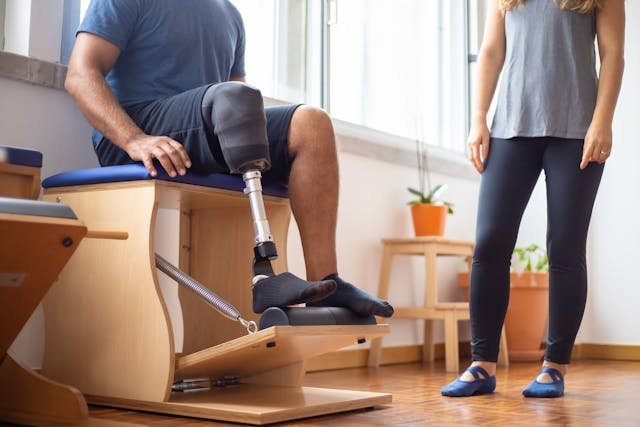
Transfemoral users have a more complex path to mobility, but with the right training, they can walk with confidence and even take on activities they once thought impossible. The key is learning to control the prosthetic knee joint and retraining the hips for movement.
Understanding and Controlling the Knee
The prosthetic knee is the most important part of a transfemoral system. It must stay firm during standing and bend smoothly during walking. Learning to control the knee starts with knowing how it works—whether it’s mechanical or microprocessor-controlled.
Standing straight, keeping hips level, and pushing slightly through the toe at the right moment are all part of knee control. With practice, the user learns how to time each movement to match the pace and resistance of the knee.
Robobionics helps users practice these movements with step-by-step guidance and support. With time, transfemoral users begin to walk with rhythm, allowing the knee to flow with the body instead of feeling like a separate part.
Strengthening the Hip and Core for Stability
Without a natural knee, the body depends more on the hip and core muscles to lift, swing, and control the leg. That’s why strength training for transfemoral users focuses on these areas first.
Exercises like hip bridges, standing leg swings, and seated core movements help build the stability needed to balance during steps. As these muscles grow stronger, walking becomes less tiring and more controlled.
The stronger your core and hip, the more energy-efficient your walking will be. At Robobionics, our therapists guide users through safe, effective routines that can be done at home, making it easier to build strength without needing daily clinic visits.
Training for Real-World Walking and Safety
Walking outside, navigating curbs, or walking in crowded places requires more than just strength—it needs control, awareness, and a steady rhythm. Transfemoral users can practice walking on different surfaces, practicing step timing and posture in each situation.
At first, it’s helpful to walk with a support device or therapist nearby. As confidence grows, these tools become less necessary. Over time, users can walk on stairs, cross busy roads, and move freely in public without fear.
Mobility is not just about movement—it’s about freedom. With consistent training, our users at Robobionics find that their prosthetic becomes a trusted partner in every part of life, not just a device they wear.
Staying Consistent with Daily Training and Routine
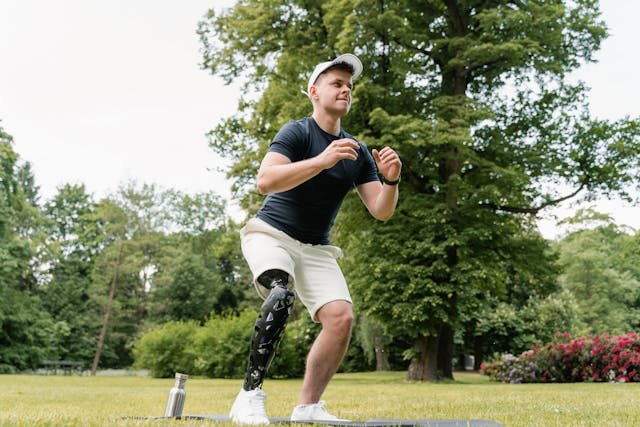
Improving mobility with a prosthetic doesn’t happen all at once. It takes time, repetition, and a routine that becomes part of your lifestyle. The more consistent your efforts, the more natural your movements become. A steady training routine not only strengthens your body but also builds confidence in using your prosthesis in real-world situations.
Turning Exercises into Daily Habits
You don’t need long, complicated workouts to build mobility. Even short sessions done regularly make a big difference. Simple exercises like balancing on both legs, walking indoors, practicing sit-to-stand movements, or doing small leg lifts can all fit into your daily schedule. The key is to repeat them every day.
By turning exercises into habits—like doing them after brushing your teeth or before meals—you build consistency without stress. Over time, these small movements improve posture, stability, and the way your body works with your prosthetic.
At Robobionics, we help users set up easy-to-follow routines that match their daily lives. Whether you’re a working professional, student, or retiree, we guide you to build a plan that fits into your day without overwhelming you.
Listening to Your Body and Making Adjustments
As you train, your body will give you feedback. Some days, your muscles might feel tired. Other times, you may notice a sore spot or that your prosthetic doesn’t feel quite right. These signs matter. They help you know when to slow down, rest, or check the fit of your socket.
Mobility training should challenge you—but it should never cause pain. If something feels off, take a break and consult your rehab specialist or prosthetist. It’s better to pause and fix a small issue than to push through and risk injury or discomfort.
Robobionics provides regular follow-ups so users can share how they’re feeling, adjust their rehab plan, or update their prosthetic fit if needed. Your success depends on how well your prosthetic and training plan work with your body—so ongoing adjustments are part of the journey.
Staying Motivated by Celebrating Progress
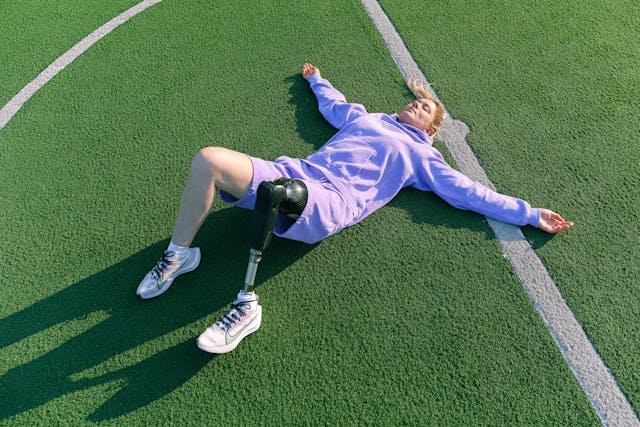
It’s easy to feel discouraged when results don’t come fast. But every step—no matter how small—is progress. Maybe you stood a little longer today, or walked a few steps without support, or noticed your balance getting better. These moments matter.
Celebrating progress helps you stay motivated. Keep a journal or take photos and videos of your journey. Look back every few weeks to see how far you’ve come. You’ll be surprised at your own strength and growth.
Robobionics encourages users to share their success stories and join our growing community of prosthetic users across India. When you see others improving and thriving, you realize you’re not alone—and that your next breakthrough might be just around the corner.
Support Systems That Make Mobility Training Easier
No one has to walk this path alone. Learning to move again after an amputation can be overwhelming at times, but the right support system makes a huge difference. From family and friends to therapists and prosthetic experts, having people by your side helps you stay strong, focused, and motivated through every phase of mobility training.
The Role of Family and Daily Support
Family members play an important role in your recovery and training process. Their encouragement, help with daily tasks, and presence during exercises can lift your spirits and keep you focused. They can also help you notice changes in your posture, gait, or comfort that you might miss on your own.
Even simple support, like watching you walk or helping you balance during a new movement, can make training feel safer. For those who live alone, having a trusted friend or neighbor check in regularly can offer emotional reassurance and practical help.
At Robobionics, we invite family members to be part of the rehabilitation journey. By including them in the process, we build a stronger circle of care that boosts the user’s confidence and creates a more supportive home environment.
Working with Experts Who Understand Your Needs
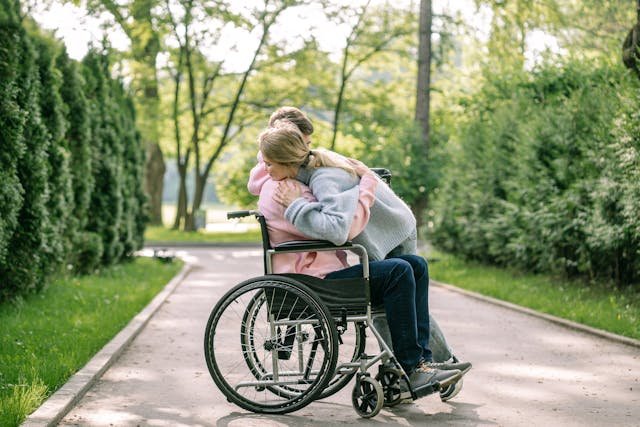
Your physiotherapist and prosthetist are your training partners. They help you understand how your body is responding, what exercises to do, and how to use your prosthetic correctly. Their feedback helps you walk better, avoid mistakes, and stay motivated.
Regular check-ins with your prosthetic team can prevent small issues from becoming big problems. Whether it’s a pressure point in the socket, a worn-out liner, or a small limp in your walk, your care team can help correct it quickly and keep you on track.
Robobionics works with a nationwide network of clinics and therapists who understand transtibial and transfemoral rehabilitation. We believe expert care should be accessible—not just at the start, but all the way through your journey.
Building Strength Through Peer Support
Talking to someone who has already walked in your shoes can be incredibly motivating. Peer support offers more than advice—it gives you proof that progress is possible. Hearing how someone overcame a similar challenge, or simply sharing your daily wins, can make a hard day feel easier.
Many users gain valuable tips from others who’ve mastered the same prosthetic type. Whether it’s how to manage sweat, improve socket comfort, or handle public spaces with more ease, peer conversations offer insights that only real-life experience can bring.
Conclusion
Training and improving mobility with a transtibial or transfemoral prosthetic is not just about learning to walk—it’s about learning to move with purpose, confidence, and independence. It takes time, strength, and consistency, but every small step adds up to meaningful progress. From the first time you stand with your prosthetic to the day you walk without thinking about it, the journey is deeply personal—and deeply powerful.
Whether you’re starting with a below-knee prosthetic or adjusting to a more complex above-knee system, the path forward is built on practice, trust, and the right support. With regular training, strong muscles, smart movement techniques, and guidance from experts, your prosthetic becomes more than a tool—it becomes a part of you.
At Robobionics, we’re here to support you every step of the way. With custom prosthetics, expert care, home-based rehabilitation tools, and a strong community, we help make mobility feel possible, achievable, and sustainable. You don’t have to walk alone—and you don’t have to wait to start.
Book a free consultation with Robobionics today and discover how the right training, tools, and support can help you walk stronger, move better, and live more freely.



